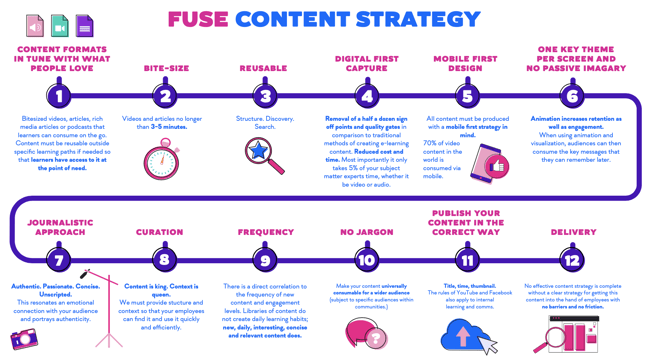
Today I am back talking to Ryan McBride, Global Head of Content at Fuse about the 12 Commandments of Content his team follows to create content that learners love, and which drives business growth. We’re delving into the third set of commandments in his team’s content methodology, after exploring the perfect structure and form of learning content in part I of the series, and the importance of digital and mobile first in learning in part II.
Hand on my heart, I’m already aware of Ryan’s passion for the first in our third set of content commandments: he’s a big fan of the journalistic approach he and his team use and advocate when speaking to subject matter experts (SMEs). So, without further ado, today’s session can only be a Q&A to get the inside scoop straight from Twickenham with the man himself, Ryan McBride.
Q: Hi Ryan. So, in our last conversation, you described to me the long and tedious process of making a SCORM course. Today, I am looking at commandment number 7: ‘a journalistic approach: authentic, passionate, concise, unscripted. This resonates an emotional connection with your audience and portrays authenticity.’ It’s an approach you’re a big believer in - why?
A: The journalistic approach is my absolute favorite thing that we do at Fuse. So, imagine one week we're making videos with GSK about groundbreaking medicines. The next week, we're doing Adidas trainers or Lego sales enablement. We could be making learning videos about anything, but it doesn’t mean I’m an expert on any one of these things.
It’s the people within the business that are the true experts, and with our journalistic approach, we simply ask them about it intelligently until we understand it. We embrace that curiosity and shoot them questions, unscripted, and get answers, unscripted. The way we bring out the passion and the authenticity of an internal SME, producing content that resonates so much better with their audience.
Speed is also key here. We ask our SMEs until we understand it, we edit it up, and send it over to them for a quick approval, and boom, it’s done. It’s like a pop quiz that results in some really, really valuable bite sized content that a company doesn’t have to slave over for six months.
Q: What if customers want to create the content themselves?
A: We love working with creative clients who want to create content for themselves, and sharing best practices from what we’ve learned over many years of client interactions. And we love coaching them in this very same journalistic approach and seeing the amazing results it produces. The content our clients create is also consistently leading to a far more engaged audience of learners, just like the content my team produces.
Q: Great. So, let’s move on to one of the most important, but most often overlooked fundamentals of content in learning: curation. Curation is explained in commandment 8 in the methodology as: “we must provide structure and context so that employees can find it and use it quickly and efficiently.” Can you tell me more about why curation is important within a learning context?
A: Sure. Up until now, we’ve been talking about the format of content, and then with the journalistic approach, we moved into how content is sourced and produced. With curation, we’re talking about how content must exist within an infrastructure in order for it to actually be useful, and for it to be located and used.
Despite how easy it is to get up and running with Fuse and how tempting it must be to jam pack it with third party and in-house generated content, our users don’t do that. While Fuse makes use of aggregation technology to gather content, we advocate curation to make sure users only see the content that is meaningful to them, as otherwise they might get overwhelmed and not learn anything.
My colleague Rhys Giles writes a lot about this, and perhaps his definition is best:
“Aggregation is the collection of related content items (which is often automated) that can then be displayed or linked to. It’s rooted in efficiency, however, on its own it can cause what we call ‘choice fatigue’ (think Netflix) because it may return too many results because it simply collates content into a library.
Curation on the other hand is the action or process of selecting, organising, and looking after items in a collection or exhibition. It’s a thoughtful process and one that shouldn’t be automated. Unlike aggregation which can often be automated, in learning platforms, curation is usually performed by humans.” Read more in Why Content Curation Beats Aggregation in Learning.
Getting the relevant pieces of content together may be the job of the admin of a given community or within certain job roles or departments so that the content that's in there speaks directly to anybody that belongs in the community. This means that people will be interacting and learning from content that has been carefully curated by the right people so that it’s the most relevant content. It’s a foundational part of the content strategy and one that our users find extremely useful.
Q: Last commandment in this set of three: frequency. So this commandment number nine says: “there’s a direct correlation to the frequency of new content and engagement levels. Libraries of next content do not create daily learning habits: new daily interesting, concise and relevant content does. Tell us more, and are there any great examples of users who really excel at this?
A: If there’s one phrase you’ll hear again and again at Fuse, it’s ‘a regular drumbeat of content’ - it’s probably still echoing in the virtual halls of Fuse as we speak. A regular drumbeat of content is like the lifeblood of a good content and learning strategy, and it’s the key to sustaining engagement.
Fuse President and Founder Steve Dineen describes it best when he talks about how L&D can use many companies use social media principals to drive engagement and performance:
“Vodafone has been a great example of content that has been successfully designed to engage, and this is entirely down to how useful the content is. The company regularly updates the platform with useful, bite-sized content. They understand that it is key to have quality content that is visually engaging, authentic and delivered with the right strategy and medium in mind.”
Scandic Hotels, a Fuse customer, also does a good job of highlighting the ‘frequency’ commandment and its correlation with engagement. It changed its culture by empowering its 18,000 staff to make learning content. Its food and beverage team in particular is full of SMEs all too happy to show their peers how to make the perfect omelette or concoct the perfect cocktail, and it’s done quickly and easily.
Whether it’s my team content developers working on the content, or your team taught by my developers, Fuse is all about empowering SMEs to make that content production second nature, which means it’s going to be that much easier to make it a consistent part of working life.
*Stay tuned for part IV, the final in the content methodology series, where we’ll talk to Ryan about his ‘no jargon’ rule, and publishing and delivering content the right way.

These Stories on Fuse Content
© 2022 Fuse Universal - All Rights Reserved
No Comments Yet
Let us know what you think